Exploring the Effects of Tourism Development on Air Pollution: Evidence from the Panel Smooth Transition Regression Model
Abstract
:1. Introduction
2. Literature Review
2.1. The Effect of Tourism on Air Pollution
2.2. Tourism-Induced EKC Hypothesis
3. Theoretical Analysis, Method, and Data
3.1. Theoretical Analysis
3.2. Method
3.2.1. Panel Smooth Transition Regression Model
3.2.2. Linearity Test and Non-Remaining Nonlinearity Test
3.3. Variable Selection and Data Sources
3.4. Model Setting
4. Empirical Results
5. Discussion and Conclusions
5.1. Theoretical and Policy Implications
5.2. Limitation and Future Research
Author Contributions
Funding
Institutional Review Board Statement
Informed Consent Statement
Data Availability Statement
Conflicts of Interest
References
- Zuo, B.; Huang, S.S. Revisiting the tourism-led economic growth hypothesis: The case of China. J. Travel Res. 2018, 57, 151–163. [Google Scholar] [CrossRef]
- Liu, H.H.; Xiao, Y.; Wang, B.; Wu, D.T. Effects of tourism development on economic growth: An empirical study of China based on both static and dynamic spatial Durbin models. Tour. Econ. 2021. [Google Scholar] [CrossRef]
- Kocak, E.; Ulucak, R.; Ulucak, Z.S. The impact of tourism developments on CO2 emissions: An advanced panel data estimation. Tour. Manag. Persp. 2020, 33, 100611. [Google Scholar]
- Li, S.S.; Lv, Z.K. Do spatial spillovers matter? Estimating the impact of tourism development on CO2 emissions. Environ. Sci. Pollut. Res. 2021, 28, 32777–32794. [Google Scholar] [CrossRef]
- Williams, P.W.; Ponsford, I.F. Confronting tourism’s environmental paradox: Transitioning for sustainable tourism. Futures 2009, 41, 396–404. [Google Scholar] [CrossRef]
- Xue, L.; Gao, J. Negotiating air pollution as a travel constraint: An exploratory study. J. Sustain. Tour. 2022, 30, 185–198. [Google Scholar] [CrossRef]
- Deng, T.; Li, X.; Ma, M. Evaluating impact of air pollution on China’s inbound tourism industry: A spatial econometric approach. Asia Pac. J. Tour. Res. 2017, 22, 771–780. [Google Scholar] [CrossRef]
- Zeng, J.J.; Wen, Y.L.; Bi, C.; Feiock, R. Effect of tourism development on urban air pollution in China: The moderating role of tourism infrastructure. J. Clean. Prod. 2021, 280, 124397. [Google Scholar] [CrossRef]
- Xiong, C.; Khan, A.; Bibi, S.; Hayat, H.; Jiang, S.P. Tourism subindustry level environmental impacts in the US. Curr. Issues Tour. 2022, 1–19. [Google Scholar] [CrossRef]
- Tian, X.L.; Bélaïd, F.; Ahmad, N. Exploring the nexus between tourism development and environmental quality: Role of Renewable energy consumption and Income. Struct. Chang. Econ. Dyn. 2021, 56, 53–63. [Google Scholar] [CrossRef]
- Tang, C.C.; Zhong, L.S.; Ng, P. Factors that influence the tourism industry’s carbon emissions: A tourism area life cycle model perspective. Energy Policy 2017, 109, 704–718. [Google Scholar] [CrossRef]
- Ahmad, N.; Ma, X.J. How does tourism development affect environmental pollution? Tour. Econ. 2021; published online. [Google Scholar] [CrossRef]
- Higham, J.; Cohen, S.A.; Cavaliere, C.T.; Reis, A.C.; Finkler, W. Climate change, tourist air travel and radical emissions reduction. J. Clean. Prod. 2016, 111 (Part B), 336–347. [Google Scholar] [CrossRef] [Green Version]
- Saenz-de-Miera, O.; Rosselló, J. Modeling tourism impacts on air pollution: The case study of PM10 in Mallorca. Tour. Manag. 2014, 40, 273–281. [Google Scholar] [CrossRef]
- Azam, M.; Mahmudulalam, M.; Haroon-Hafeez, M. Effect of tourism on environmental pollution: Further evidence from Malaysia, Singapore and Thailand. J. Clean. Prod. 2018, 190, 330–338. [Google Scholar] [CrossRef]
- Paramati, S.R.; Alam, M.S.; Chen, C.F. The effects of tourism on economic growth and CO2 emissions: A comparison between developed and developing economies. J. Travel Res. 2017, 56, 712–724. [Google Scholar] [CrossRef] [Green Version]
- Sherafatian-Jahromi, R.; Othman, M.S.; Law, S.H.; Ismail, N.W. Tourism and CO2 Emissions Nexus in Southeast Asia: New Evidence from Panel Estimation. Environ. Dev. Sustain. 2017, 19, 1407–1423. [Google Scholar] [CrossRef]
- Katircioglu, S.; Gokmenoglu, K.K.; Eren, B.M. Testing the role of tourism development in ecological footprint quality: Evidence from top 10 tourist destinations. Environ. Sci. Pollut. Res. 2018, 25, 33611–33619. [Google Scholar] [CrossRef]
- Arellano, M.; Bond, S. Some tests of specification for panel data: Monte Carlo evidence and an application to employment equations. Rev. Econ. Stud. 1991, 58, 277–297. [Google Scholar] [CrossRef] [Green Version]
- Blundell, R.; Bond, S. Initial conditions and moment restrictions in dynamic panel data models. J. Econometr. 1998, 87, 115–143. [Google Scholar] [CrossRef] [Green Version]
- Chiu, Y.B.; Lee, C.C. Effects of financial development on energy consumption: The role of country risks. Energy Econ. 2020, 90, 104833. [Google Scholar] [CrossRef]
- Zhang, L.; Gao, J. Exploring the effects of international tourism on China’s economic growth, energy consumption and environmental pollution: Evidence from a regional panel analysis. Renew. Sustain. Energy Rev. 2016, 53, 225–234. [Google Scholar] [CrossRef]
- Rico, A.; Martínez-blanco, J.; Montlleó, M.; Rodríguez, G.; Tavares, N.; Arias, A.; Oliver-Solà, J. Carbon footprint of tourism in Barcelona. Tour. Manag. 2019, 70, 491–504. [Google Scholar] [CrossRef]
- Robaina, M.; Madaleno, M.; Silva, S.; Eusébio, C.; Carneiro, M.J.; Gama, C.; Oliveira, K.; Russo, M.A.; Monteiro, A. The relationship between tourism and air quality in five European countries. Econ. Anal. Policy 2020, 67, 261–272. [Google Scholar] [CrossRef]
- Lee, J.W.; Brahmasrene, T. Investigating the influence of tourism on economic growth and carbon emissions: Evidence from panel analysis of the European Union. Tour. Manag. 2013, 38, 69–76. [Google Scholar] [CrossRef]
- Bojanic, D.C.; Warnic, R.B. The Relationship between a country’s level of tourism and environmental performance. J. Travel Res. 2020, 59, 220–230. [Google Scholar] [CrossRef]
- Ciarlantini, S.; Madaleno, M.; Robaina, M.; Monteiro, A. Air pollution and tourism growth relationship: Exploring regional dynamics in five European countries through an EKC model. Environ. Sci. Pollut. Res. 2022, 1–19. [Google Scholar] [CrossRef]
- Balsalobre-Lorentes, D.; Driha, O.M.; Sinha, A. The dynamic effects of globalization process in analyzing N-shaped tourism led growth hypothesis. J. Hosp. Tour. Manag. 2020, 43, 42–52. [Google Scholar] [CrossRef]
- Bi, C.; Zeng, J.J. Nonlinear and spatial effects of tourism on carbon emissions in China: A spatial econometric approach. Int. J. Environ. Res. Public Health 2019, 16, 3353. [Google Scholar] [CrossRef] [Green Version]
- Halicioglu, F. An econometric study of CO2 emissions, energy consumption, income and foreign trade in Turkey. Energy Policy 2009, 37, 1156–1164. [Google Scholar] [CrossRef] [Green Version]
- Yang, G.F.; Sun, T.; Wang, J.L.; Li, X.N. Modeling the nexus between carbon dioxide emissions and economic growth. Energy Policy 2015, 86, 104–117. [Google Scholar] [CrossRef]
- Cai, H.; Mei, Y.D.; Chen, J.H.; Wu, Z.H.; Lan, L. An analysis of the relation between water pollution and economic growth in China by considering the contemporaneous correlation of water pollutants. J. Clean. Prod. 2020, 276, 122783. [Google Scholar] [CrossRef]
- Katircioğlu, S.T. Testing the tourism-induced EKC hypothesis: The case of Singapore. Econ. Model. 2014, 41, 383–391. [Google Scholar] [CrossRef]
- De Vita, G.; Katircioglu, S.; Altinay, L.; Fethi, S.; Mercan, M. Revisiting the environmental Kuznets curve hypothesis in a tourism development context. Environ. Sci. Pollut. Res. 2015, 22, 16652–16663. [Google Scholar] [CrossRef]
- Shakouri, B.; Khoshnevis Yazdi, S.; Ghorchebigi, E. Does tourism development promote CO2 emissions? Anatolia 2017, 28, 444–452. [Google Scholar] [CrossRef]
- Akadiri, S.S.; Akadiri, A.C.; Alola, U.V. Is there growth impact of tourism? Evidence from selected small island states. Curr. Issues Tour. 2019, 22, 1480–1498. [Google Scholar] [CrossRef]
- Gao, J.; Zhang, L. Exploring the dynamic linkages between tourism growth and environmental pollution: New evidence from the Mediterranean countries. Curr. Issues Tour. 2021, 24, 49–65. [Google Scholar] [CrossRef]
- Yıldırım, S.; Yıldırım, D.C.; Aydın, K.; Erdoğan, F. Regime-dependent effect of tourism on carbon emissions in the Mediterranean countries. Environ. Sci. Pollut. Res. 2021, 28, 54766–54780. [Google Scholar] [CrossRef]
- Gómez, C.; Lozano, J.; Rey-Maquieira, J. Environmental policy and long-term welfare in a tourism economy. Span. Econ. Rev. 2008, 10, 41–62. [Google Scholar] [CrossRef]
- Nowak, J.J.; Sahli, M. Coastal tourism and ‘Dutch disease’ in a small island economy. Tour. Econ. 2007, 13, 49–65. [Google Scholar] [CrossRef]
- Gonzalez, A.; Terasvirta, T.; van Dijk, D. Panel smooth transition regression models. In SEE/EFI Working Paper Series in Economics and Finance; Stockholm School of Economics: Stockholm, Sweden, 2005; p. 604. [Google Scholar]
- Seleteng, M.; Bittencourt, M.; van Eyden, R. Non-linearities in inflation–growth nexus in the SADC region: A panel smooth transition regression approach. Econ. Model. 2013, 30, 149–156. [Google Scholar] [CrossRef] [Green Version]
- Pan, J.N.; Huang, J.T.; Chiang, T.F. Empirical study of the local government deficit, land finance and real estate markets in China. China Econ. Rev. 2015, 32, 57–67. [Google Scholar] [CrossRef]
- Duarte, R.; Pinilla, V.; Serrano, A. Is there an environmental Kuznets curve for water use? A panel smooth transition regression approach. Econ. Model. 2013, 31, 518–527. [Google Scholar] [CrossRef] [Green Version]
- Zhang, M.M.; Zhang, S.C.; Lee, C.C.; Zhou, D.Q. Effects of trade openness on renewable energy consumption in OECD countries: New insights from panel smooth transition regression modelling. Energy Econ. 2021, 104, 105649. [Google Scholar] [CrossRef]
- Cheikh, N.B.; Zaied, Y.B.; Chevallier, J. On the nonlinear relationship between energy use and CO2 emissions within an EKC framework: Evidence from panel smooth transition regression in the MENA region. Res. Int. Bus. Financ. 2021, 55, 101331. [Google Scholar] [CrossRef]
- Colletaz, G.; Hurlin, C. Threshold Effects of the Public Capital Productivity: An International Panel Smooth Transition Approach; University of Orleans: Orléans, France, 2006. [Google Scholar]
- Li, Z.Y.; Shu, H.Y.; Tan, T.; Huang, S.S.; Zha, J.P. Does the demographic structure affect outbound tourism demand? A panel smooth transition regression approach. J. Travel Res. 2020, 59, 893–908. [Google Scholar] [CrossRef]
- Fouquau, J.; Hurlin, C.; Rabaud, I. The Feldstein–Horioka puzzle: A panel smooth transition regression approach. Econ. Model. 2008, 25, 284–299. [Google Scholar] [CrossRef]
- Lahouel, B.B.; Zaied, Y.B.; Managi, S.; Taleb, L. Re-thinking about U: The relevance of regime-switching model in the relationship between environmental corporate social responsibility and financial performance. J. Bus. Res. 2022, 140, 498–519. [Google Scholar] [CrossRef]
- Xu, D.; Huang, Z.; Hou, G.; Zhang, C. The spatial spillover effects of haze pollution on inbound tourism: Evidence from mid-eastern China. Tour. Geogr. 2020, 22, 83–104. [Google Scholar] [CrossRef]
- Zhang, N.; Ren, R.; Zhang, Q.; Zhang, T. Air pollution and tourism development: An interplay. Ann. Tour. Res. 2020, 85, 103032. [Google Scholar] [CrossRef]
- Lin, S.F.; Zhao, D.T.; Marinova, C. Analysis of the environmental impact of China based on STIRPAT model. Environ. Impact Assess. Rev. 2009, 29, 341–347. [Google Scholar] [CrossRef]
- Sarzynski, A. Bigger is not always better: A comparative analysis of cities and their air pollution impact. Urban Stud. 2012, 49, 3121–3138. [Google Scholar] [CrossRef]
- Sun, C.W.; Luo, Y.; Li, J.L. Urban traffic infrastructure investment and air pollution: Evidence from the 83 cities in China. J. Clean. Prod. 2018, 172, 488–496. [Google Scholar] [CrossRef]
- York, R.; Rosa, E.A.; Dietz, T. Footprints on the earth: The environmental consequences of modernity. Am. Sociol. Rev. 2003, 68, 279–300. [Google Scholar] [CrossRef]
- Liddle, B. Impact of population, age structure, and urbanization on carbon emissions/energy consumption: Evidence from macro-level, cross-country analyses. Popul. Environ. 2014, 35, 286–304. [Google Scholar] [CrossRef] [Green Version]
- Yang, Y.; Wong, K.K.F. A spatial econometric approach to model spillover effects in tourism flows. J. Travel Res. 2012, 51, 768–778. [Google Scholar] [CrossRef]
- Wang, Q.; Zhang, F. What does the China’s economic recovery after COVID-19 pandemic mean for the economic growth and energy consumption of other countries? J. Clean. Prod. 2021, 295, 126265. [Google Scholar] [CrossRef]
- Bella, G. Estimating the tourism induced environmental Kuznets curve in France. J. Sustain. Tour. 2018, 26, 2043–2052. [Google Scholar] [CrossRef]
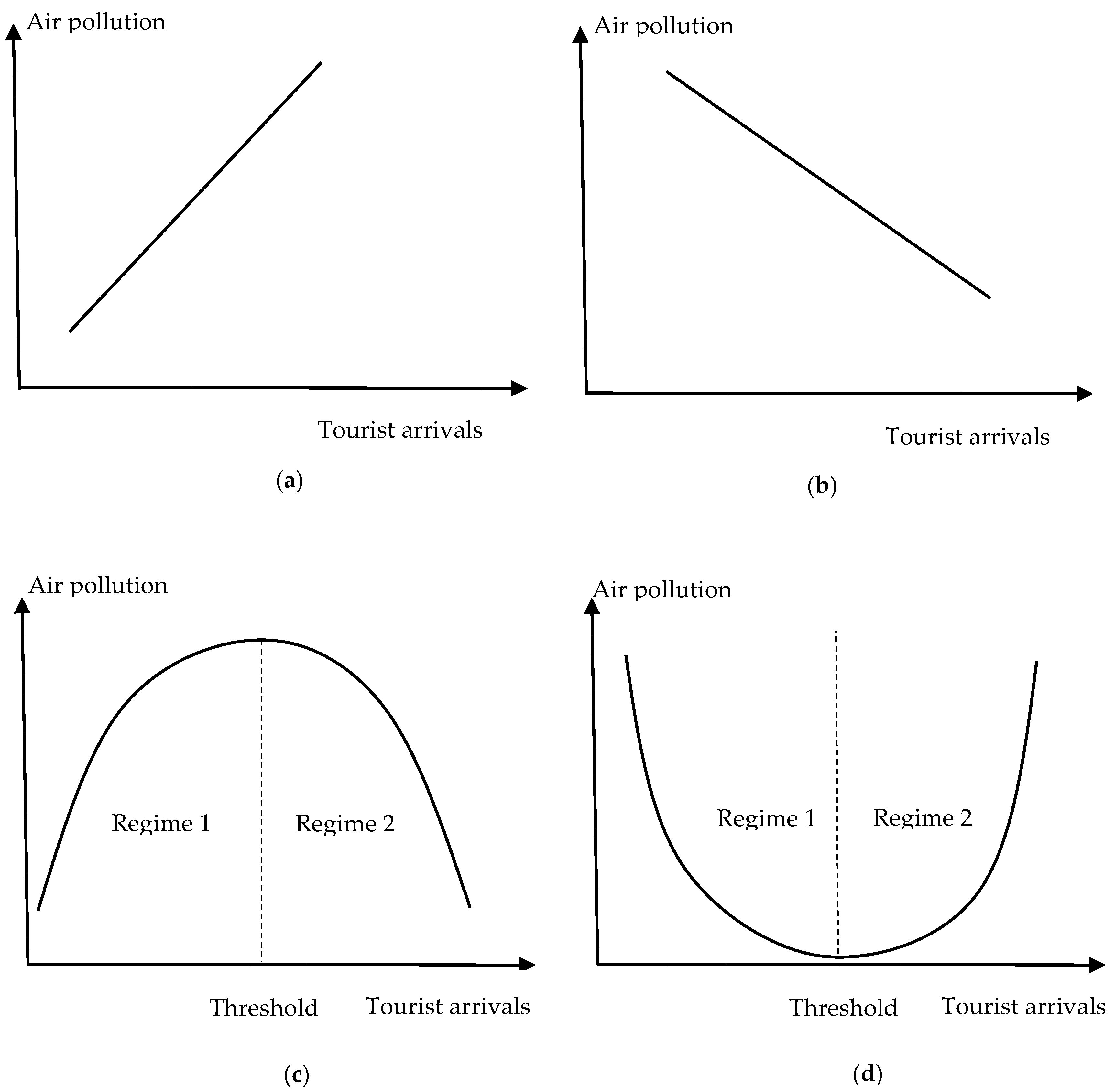
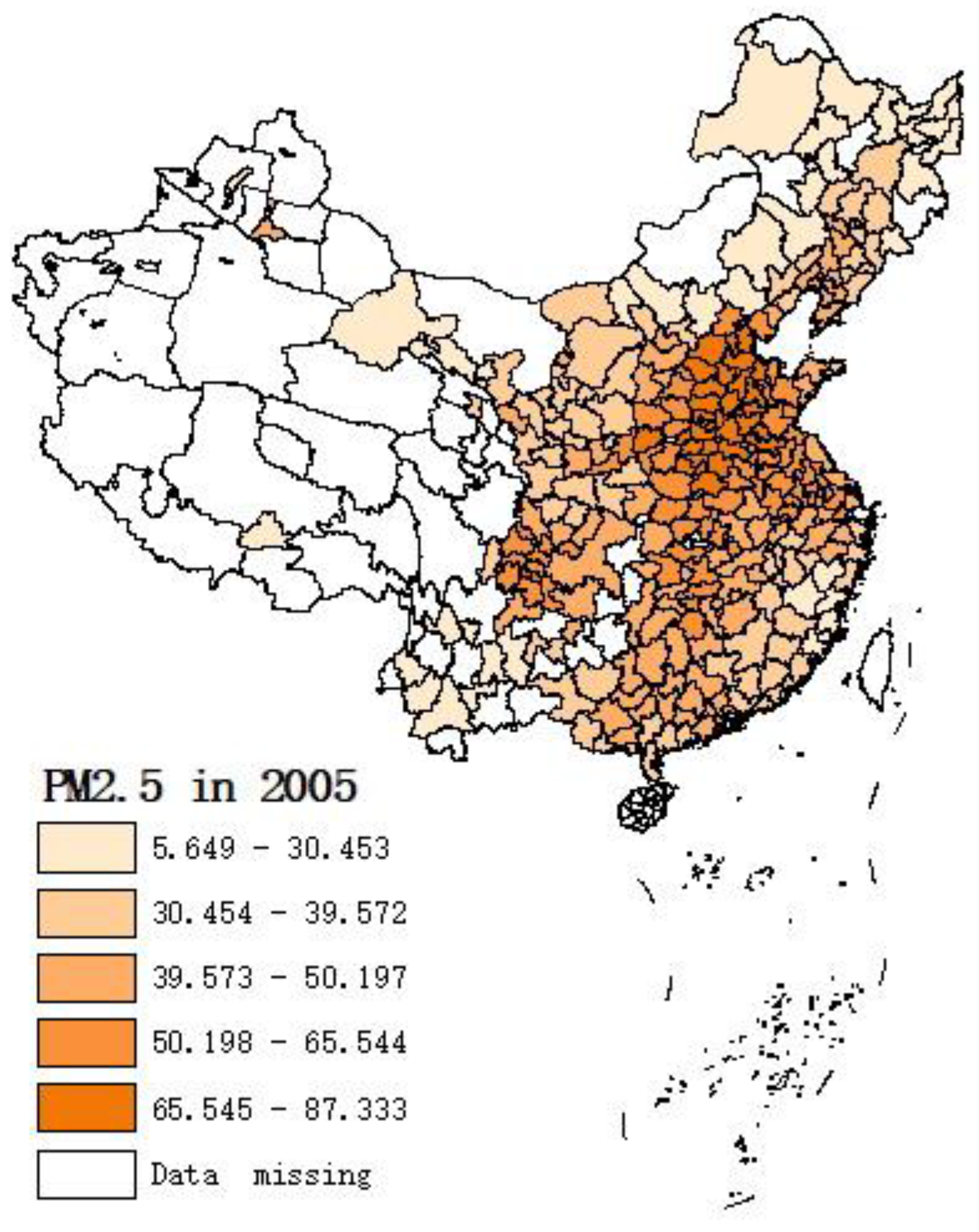
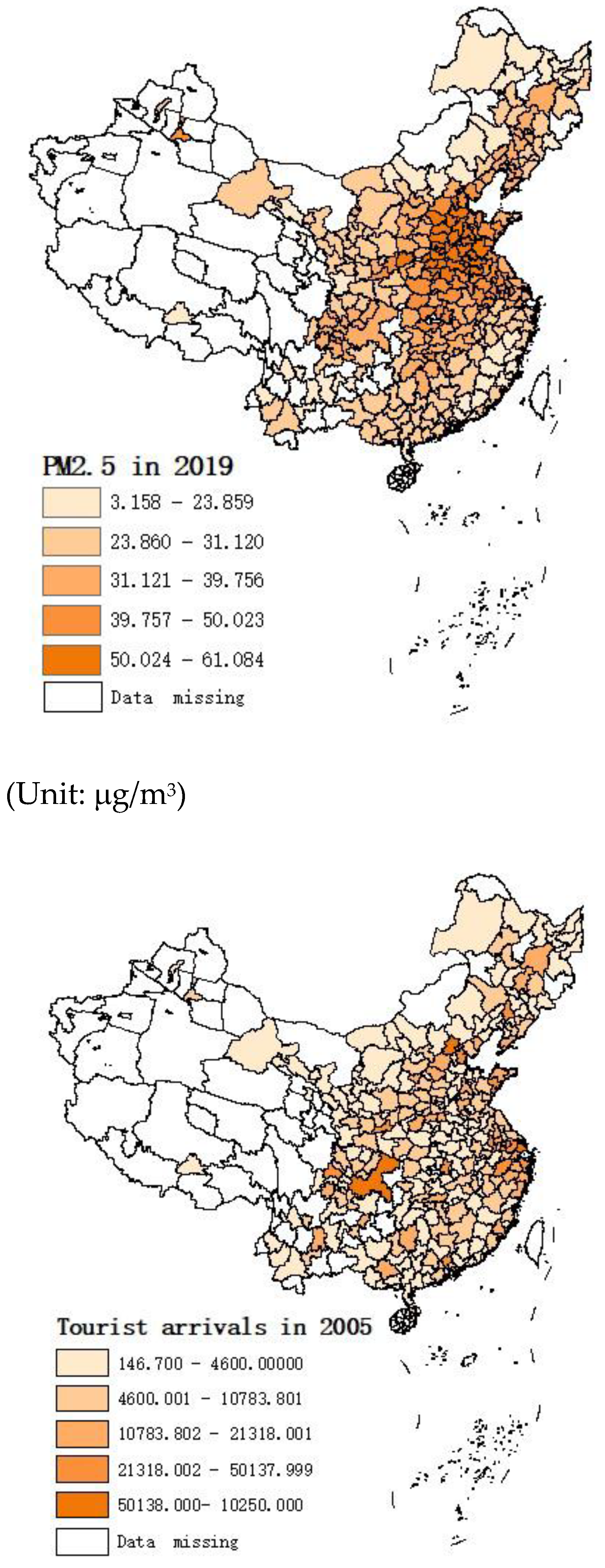
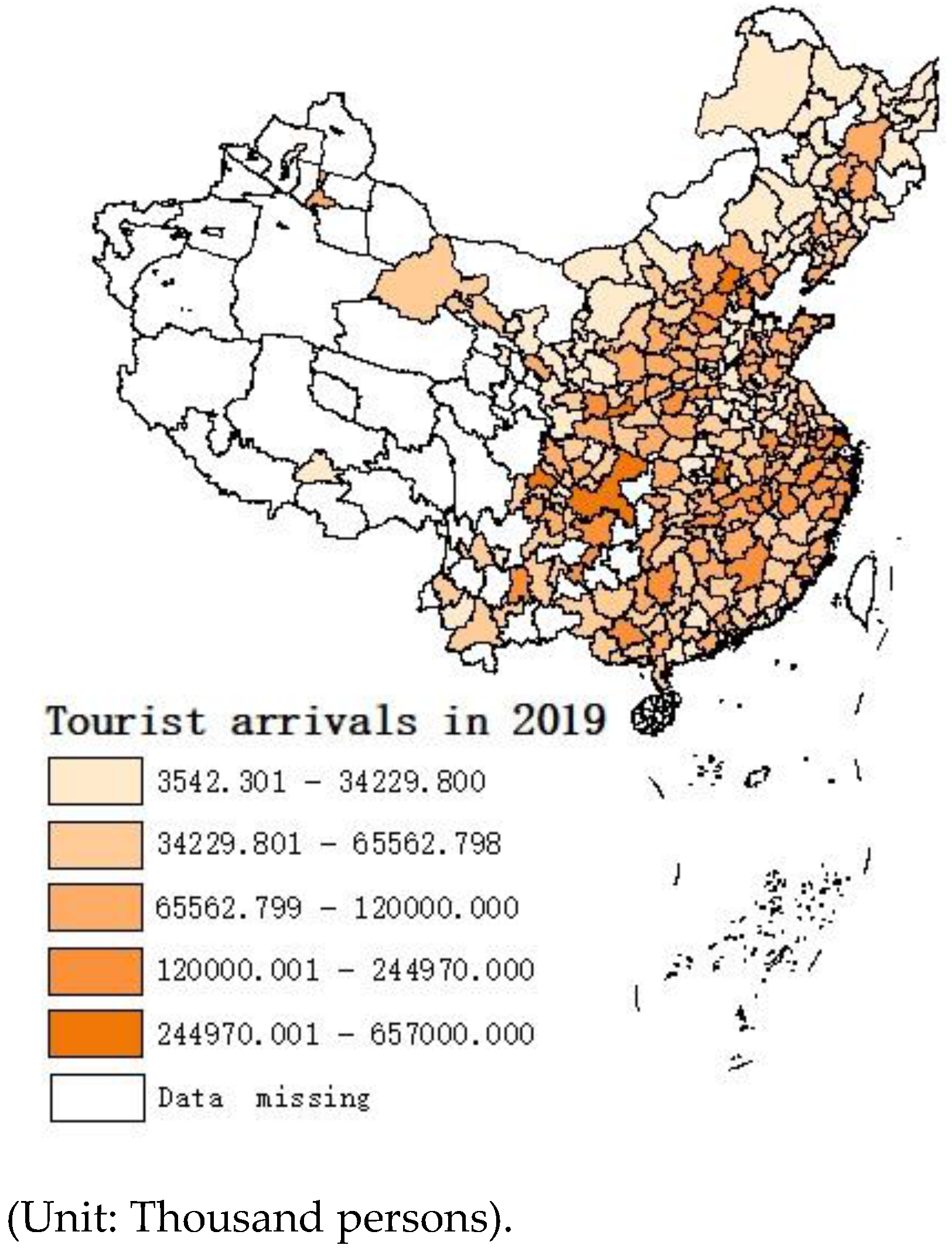

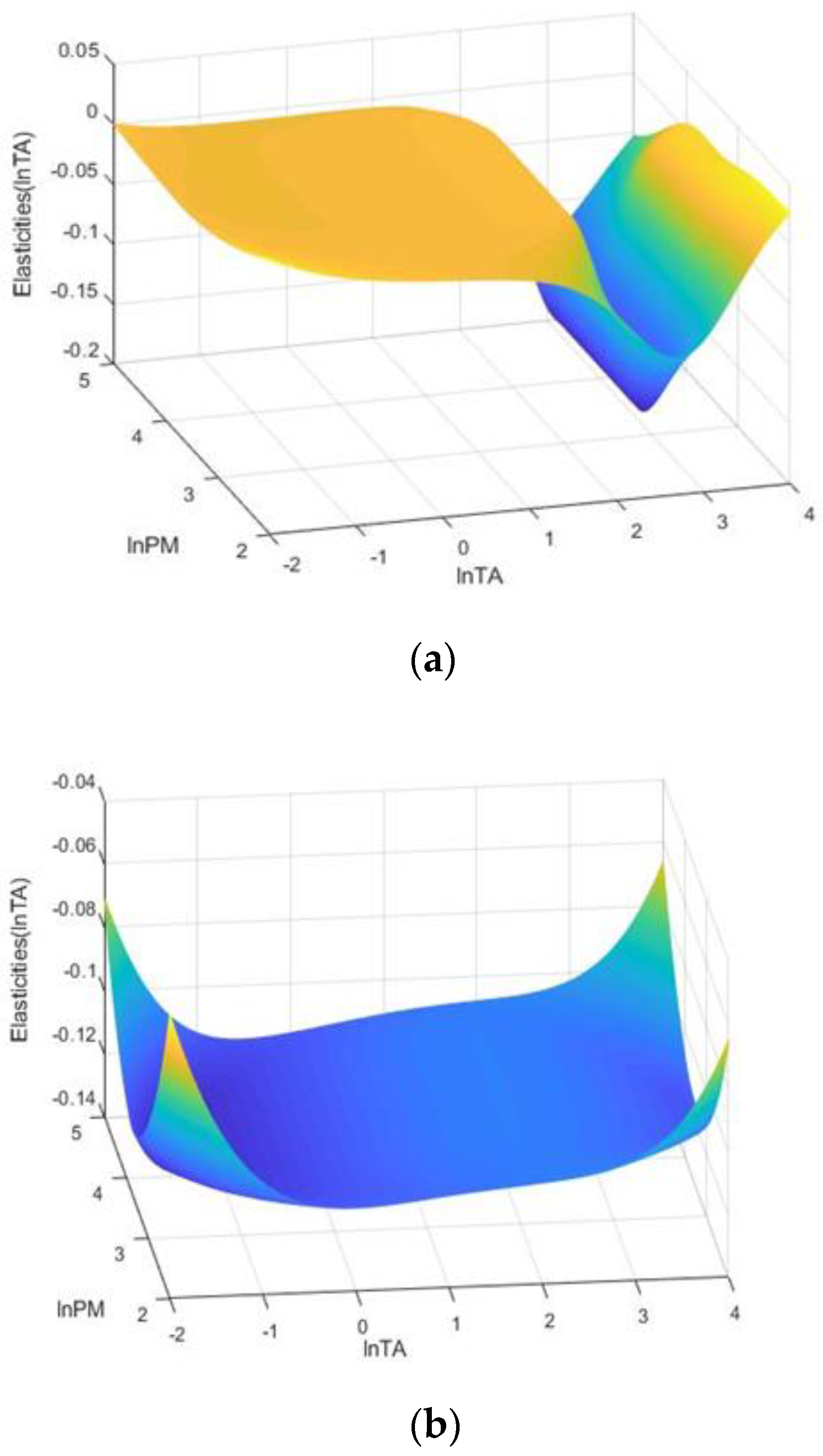
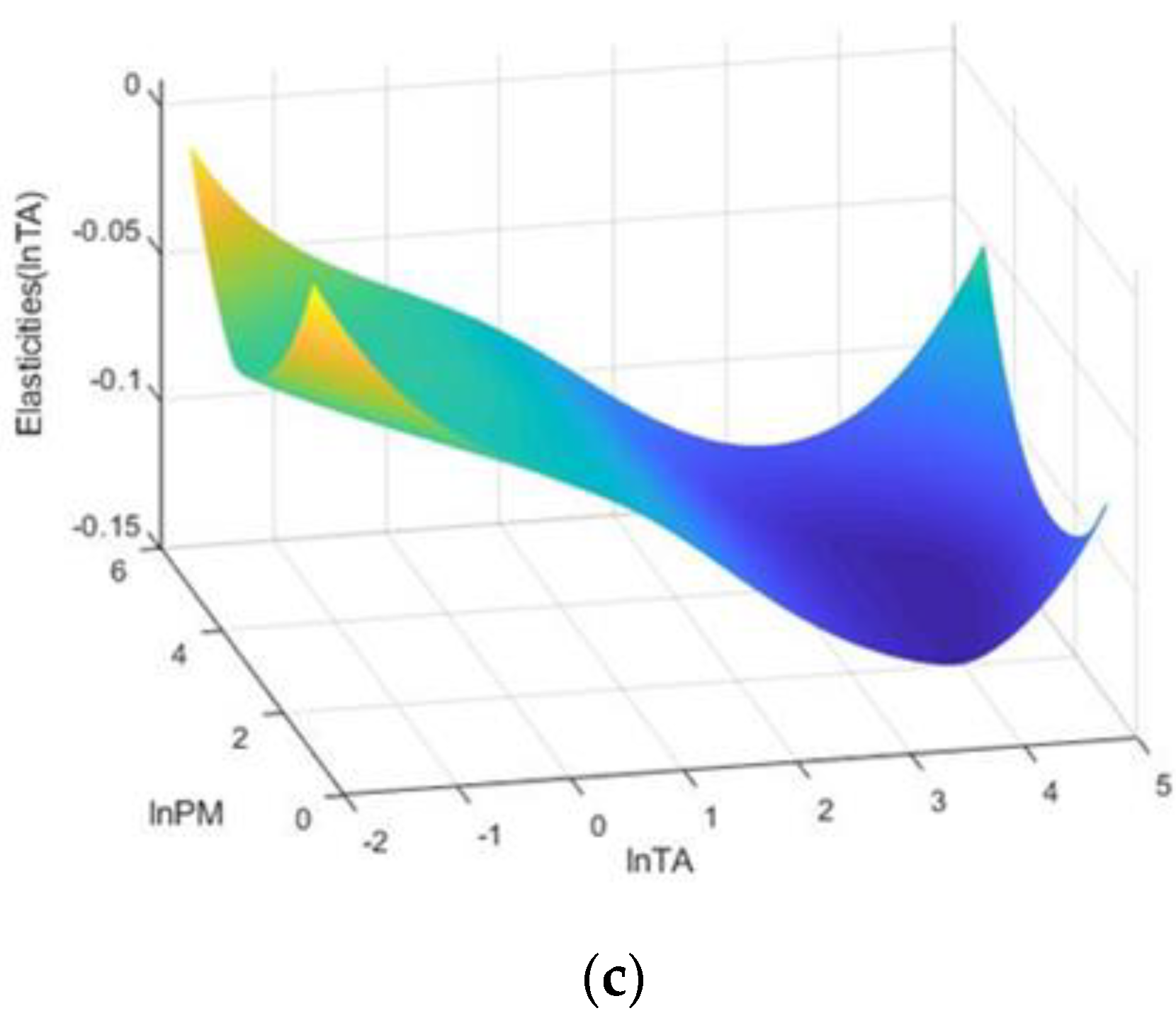
| Variables | Definition | Obs | Mean | SD | Min | Max |
|---|---|---|---|---|---|---|
| lnPM | Logarithm of annual average PM2.5 concentrations (μg/m3) | 4025 | 3.751 | 0.360 | 1.150 | 4.687 |
| lnTA | Logarithm of the ratio of total tourist arrivals to the local inhabitants | 4025 | 1.389 | 1.061 | −1.986 | 4.286 |
| lnPGDP | Logarithm of per capital GDP (CNY) | 4025 | 2.333 | 0.105 | 0 | 2.752 |
| lnDENS | Logarithm of the ratio of local inhabitants to urban area (million persons /10,000 km2) | 4025 | −1.185 | 0.933 | −5.36 | 1.015 |
| lnTECH | Logarithm of the ratio of Investment in Science and Technology to public expenditure of government | 4025 | −4.757 | 1.246 | −15.538 | 0 |
| lnINVEST | Logarithm of the ratio of fixed capital investment to GDP | 4025 | −0.410 | 0.601 | −3.655 | 2.396 |
| lnTRAFF | Logarithm of the ratio of the total passenger traffic volume of highway, railway transport, and civil aviation to local inhabitants | 4025 | 2.577 | 0.882 | −5.138 | 8.144 |
| lnGREEN | Logarithm of the ratio of green coverage to urban area | 4025 | −0.989 | 0.397 | −5.627 | 1.352 |
| LLC | IPS | ADF−Fisher | ADF−PP | Conclusion | |
|---|---|---|---|---|---|
| lnPM | 1.162 | 14.464 | 178.191 | 400.978 | Nonstationary |
| D.lnPM | 18.425 *** | 16.258 *** | 1230.91 *** | 3629.20 *** | Stationary |
| lnTA | 9.376 *** | 1.164 | 655.301 *** | 1023.27 *** | Stationary |
| D.lnTA | 11.049 *** | 13.066 *** | 1100.53 *** | 2733.32 *** | Stationary |
| lnPGDP | −5.559 *** | 9.169 | 393.726 *** | 810.519 *** | Stationary |
| D.lnPGDP | −22.278 *** | −20.086 *** | 1454.06 *** | 4375.37 *** | Stationary |
| lnDENS | −15.329 *** | 4.365 | 469.918 | 758.046 *** | Nonstationary |
| D.lnDENS | −29.112 *** | −12.645 *** | 1011.48 *** | 2763.52 *** | Stationary |
| lnINVEST | −7.382 *** | −5.387 *** | 863.154 *** | 1875.17 *** | Stationary |
| D.lnINVEST | −9.474 *** | −16.510 *** | 1271.30 *** | 3969.88 *** | Stationary |
| lnTECH | −13.546 *** | −3.489 | 850.017 *** | 1181.34 *** | Stationary |
| D.lnTECH | −26.448 *** | −21.556 *** | 1565.70 *** | 2408.56 *** | Stationary |
| lnTRAFF | −4.067 | 6.397 | 372.726 *** | 596.351 *** | Nonstationary |
| D.lnTRAFF | −13.763 *** | −7.725 *** | 845.667 *** | 2516.24 *** | Stationary |
| lnGREEN | −27.514 *** | −8.789 *** | 898.184 *** | 1378.12 *** | Stationary |
| D.lnGREEN | −23.663 *** | −20.052 *** | 1447.31 *** | 3458.67 *** | Stationary |
| Panel Kao residual cointegration test | −6.742 *** | ||||
| H0: r = 0 vs. H1: r ≥ 1 | H0: r = 1 vs. H1: r ≥ 2 | |
|---|---|---|
| LM | 597.188 *** | 25.860 ** |
| LMF | 92.497 *** | 3.451 |
| LRT | 643.603 *** | 25.939 ** |
| AIC | BIC | |
| m = 1 | −4.668 | −4.644 |
| m = 2 | −4.667 | −4.642 |
| FE Model | PTR-FE Model | PSTR Model | ||
|---|---|---|---|---|
| Linear | Nonlinear | |||
| lnTA | −0.094 *** (0.003) | 0.098 *** (0.010) | −0.155 *** (0.016) | |
| lnPGDP | 0.006 (0.022) | 0.0005 (0.021) | 0.288 *** (0.033) | −0.574 *** (0.053) |
| lnDENS | −0.128 *** (0.028) | −0.120 *** (0.027) | 0.068 (0.046) | −0.389 *** (0.027) |
| lnTECH | 0.030 *** (0.002) | 0.029 *** (0.002) | 0.006 (0.007) | 0.062 *** (0.016) |
| lnINVEST | 0.016 *** (0.004) | 0.009 ** (0.004) | −0.014 (0.016) | 0.043 (0.034) |
| lnTRAFF | 0.045 *** (0.003) | 0.041 *** (0.003) | 0.032 *** (0.011) | 0.003 (0.025) |
| lnGREEN | −0.0004 (0.006) | −0.003 (0.005) | −0.013 (0.020) | 0.010 (0.057) |
| lnTA (lnTA < 2.045) | −0.067 * (0.003) | |||
| lnTA (lnTA ≥ 2.045) | −0.097 *** (0.003) | |||
| _cons | 3.750 *** (0.062) | 3.754 *** (0.061) | ||
| Hausman test | 81.58 *** | |||
| γ | 0.419 | |||
| c | 2.294 | |||
| N | 4245 | 4245 | ||
| Variables | East Cities | Central Cities | West Cities | ||||
|---|---|---|---|---|---|---|---|
| Linear | Nonlinear | Linear | Nonlinear | Linear | Nonlinear | ||
| lnTA | −0.357 *** (0.077) | −0.028 *** (0.014) | 0.344 *** (0.076) | −0.086 *** (0.025) | −0.044 (0.040) | −0.054 *** (0.015) | −0.087 *** (0.016) |
| lnPGDP | 0.668 *** (0.090) | −0.533 *** (0.098) | −0.676 *** (0.100) | −0.013 (0.061) | 0.069 (0.104) | 0.056 (0.063) | −0.142 *** (0.034) |
| lnDENS | −0.019 (0.095) | −0.245 *** (0.052) | −0.019 *** (0.042) | −0.185 *** (0.059) | 0.356 *** (0.041) | −0.017 (0.064) | −0.170 *** (0.014) |
| lnTECH | 0.102 *** (0.028) | −0.010 (0.025) | −0.066 *** (0.022) | 0.086 *** (0.016) | −0.098 *** (0.025) | 0.016 *** (0.004) | 0.018 * (0.010) |
| lnINVEST | −0.126 *** (0.052) | 0.222 ** (0.054) | 0.037 (0.038) | −0.359 *** (0.053) | 0.608 *** (0.093) | 0.039 *** (0.014) | −0.008 (0.019) |
| lnTRAFF | 0.075 *** (0.047) | 0.013 (0.051) | −0.042 (0.034) | 0.128 *** (0.035) | −0.187 *** (0.057) | 0.009 (0.007) | 0.060 *** (0.014) |
| lnGREEN | 0.650 (0.141) | −0.380 *** (0.142) | −0.561 *** (0.104) | −0.011 (0.072) | −0.019 (0.111) | 0.014 * (0.008) | −0.049 * (0.028) |
| γ | −0.108; 6.463 | 0.213 | 1.500 | ||||
| c | 2.362; 2.796 | 1.893 | 1.633 | ||||
| N | 1500 | 1605 | 1140 | ||||
| Linear | Nonlinear | |
|---|---|---|
| lnTR | 0.012 ** (0.005) | −0.0003 (0.006) |
| lnPGDP | −0.003 (0.043) | −0.153 *** (0.019) |
| lnDENS | −0.162 ** (0.079) | −0.110 *** (0.009) |
| lnTECH | 0.023 *** (0.003) | 0.025 *** (0.006) |
| lnINVEST | −0.020 ** (0.008) | 0.061 *** (0.011) |
| lnTRAFF | 0.044 *** (0.005) | −0.016 * (0.008) |
| lnGREEN | 0.007 (0.006) | −0.072 *** (0.017) |
| γ | 2.195 | |
| c | −1.853 | |
| N | 4245 | |
Publisher’s Note: MDPI stays neutral with regard to jurisdictional claims in published maps and institutional affiliations. |
© 2022 by the authors. Licensee MDPI, Basel, Switzerland. This article is an open access article distributed under the terms and conditions of the Creative Commons Attribution (CC BY) license (https://creativecommons.org/licenses/by/4.0/).
Share and Cite
Zhang, J.; Lu, Y. Exploring the Effects of Tourism Development on Air Pollution: Evidence from the Panel Smooth Transition Regression Model. Int. J. Environ. Res. Public Health 2022, 19, 8442. https://doi.org/10.3390/ijerph19148442
Zhang J, Lu Y. Exploring the Effects of Tourism Development on Air Pollution: Evidence from the Panel Smooth Transition Regression Model. International Journal of Environmental Research and Public Health. 2022; 19(14):8442. https://doi.org/10.3390/ijerph19148442
Chicago/Turabian StyleZhang, Jun, and Youhai Lu. 2022. "Exploring the Effects of Tourism Development on Air Pollution: Evidence from the Panel Smooth Transition Regression Model" International Journal of Environmental Research and Public Health 19, no. 14: 8442. https://doi.org/10.3390/ijerph19148442
APA StyleZhang, J., & Lu, Y. (2022). Exploring the Effects of Tourism Development on Air Pollution: Evidence from the Panel Smooth Transition Regression Model. International Journal of Environmental Research and Public Health, 19(14), 8442. https://doi.org/10.3390/ijerph19148442






